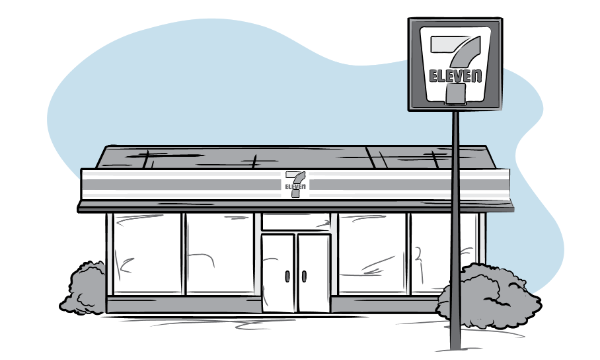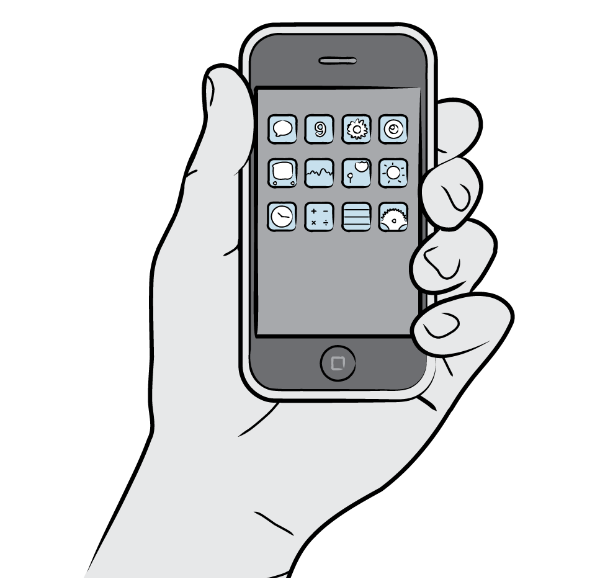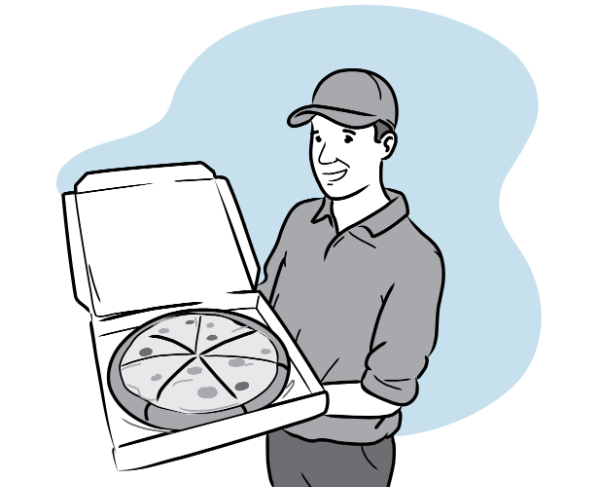Technology and innovative design have made many products and services more predictable and efficient, the two lower levels of Different’s 7 Essentials of Customer Experience. Convenience, the next essential of customer experience, is a critical factor in determining how customers make decisions about what to buy, what services to use, where to go, and with whom to engage.
Conventional wisdom says that convenience is a factor of time and effort. On the surface, that’s true, but if you dig a little deeper to fully understand service convenience, you need to consider another factor: perception.
What Is Convenience in UX?
In 1927, an entrepreneurial worker at the Southland Ice Company in Dallas, Texas began selling milk, bread, and eggs from a storefront on the ice dock to make a little extra money. Having access to an inexhaustible amount of ice for preserving the groceries, Joe Thompson was able to sell when other local grocery stores were closed in the late evenings and on weekends. For the first time, the local community could shop outside of typical business hours, whenever it suited them. Soon after, Joe added gasoline and various other food, drinks, and “convenience” items to his inventory in a new store with the unprecedented trading hours of 7 a.m. to 11 p.m. By 2011, 7-Eleven has grown to 41,000 locations worldwide and is the prototype for convenience.1 , 2
When I first started mulling over the idea of how to define and explain convenience, the convenience store was the first and most obvious example that sprang to mind. What is it about a convenience store that makes it, well, convenient? How do you define convenience considering that what one person perceives as convenient may not be all that convenient for another, or that what was convenient in the morning may be inconvenient in the afternoon? Looking through the academic research, there are some interesting theories that have built on each other, but each only tells a piece of the story.
In 1986, Yale & Venkatesh 3 proposed a framework for understanding convenience in which variables such as attitude and situational context influence an individual’s preference and need for some of the attributes of convenience. Those attributes include effective time utilization, portability, and avoidance of unpleasantness in a service. The key takeaway is that as an individual’s situation changes, his perception of what is convenient changes as well. In 1989, Brown 4defined convenience in a way that focuses on the service as opposed to the individual, breaking convenience up along the five dimensions of service: time, place, acquisition, use, and execution. In 2009, Clulow & Reimers5 performed a meta-analysis of studies of convenience in pre-existing literature, including Yale & Venkatesh and Brown, and found that convenience in retail derives from minimizing the costs of time, space, and effort.
Each definition has merit, but perhaps each has too narrow a focus when considering that customer experience can cross services, products, and contexts. Convenience in the user experience must take into account the costs of the experience (in money, effort, and other terms), a true understanding of the stages of the experience, and an understanding of customers as their needs and behaviors change from context to context. This is no simple task, but the effort is worthwhile.
Why Is Convenience Important?
In September 1999, Amazon.com set off a firestorm when they patented one-click buying6. An Australia telco has waged an eight-year battle against the patent and millions of dollars have been spent on this legal dispute around the world. Is one-click purchasing worth millions of dollars? Apparently, yes.
A 2002 study found that something is known as convenience orientation—a customer’s general preference for convenient goods and services—has a major impact on buying decisions7. The study also found that the perception of a service’s convenience affects the overall evaluation of the service. A separate study in 2007 also found that convenience was the most relevant factor in the use of mobile devices for Internet shopping8. Millions of dollars are being spent on the one-click patent dispute because convenience has a major impact on a customer’s decision to engage with service and can indeed reduce the cost to serve.
Convenience determines usage
The most popular camera used for Flickr photo uploads isn’t actually a traditional camera, it’s a phone. On a random day this year, 65,000 media items were uploaded to Flickr by over 5,000 iPhone 4 users alone9. This is clearly not because the iPhone takes superior quality pictures. The smartphone’s ubiquity, connection with online services, and relatively simple camera functionality make it a low-hassle choice for the experience of photo sharing. For Flickr, that equates to more content and more users, which in turn brings extra revenue. The convenience of uploading via the iPhone 4 is boosting Flickr’s bottom line.
Convenience reduces your costs to serve
We have known for a while that self-service applications create higher levels of perceived and actual convenience for the user. One of the first signs of this was around the 1970s when the ATM was introduced. Over time, people began to choose the ATM over a more personal service at the branch. More recently, airlines have been saving money in staff costs by using allowing boarding passes to be printed at home or at the automated kiosks at the airport. The effort of inputting data and printing the boarding documents is moving from the ticket agent onto the customer, but the perceived convenience of being in control of the experience and the very real convenience of avoiding the dreaded check-in line outweigh the extra work put on the user. It may be counterintuitive, but in some contexts, convenience means more work for the user, which can translate to reduced service costs for the company.
How to Achieve Convenience
There is no magic button and no checklist to make a service absolutely convenient. While the overall cost to users of time and effort can be monitored and managed, the perception of convenience is specific to each person. The best way to understand and implement services that are perceived as convenient to your customers is to research and design based on their needs. Once you have an understanding of your customer’s journey in buying or using your product or service, there are four key convenience strategies that are worth understanding and supporting.
Actual convenience
Actual convenience has to do with time and effort. Reduction of physical effort for undesirable tasks can come in a variety of forms, such as frozen meals that eliminate the need to cook, or online shopping that removes the need to travel. Modern technology has provided a variety of tools for bringing goods and services closer to the customer. Banking was once consigned just to the branch, but the spread of ATMs and then of web and mobile banking has moved the service to the customer. Now walking a block to find an ATM has become inconvenient. Businesses that remove the need for customers to make their own way to the service, such as free shuttles from hotels and airports, or that bring the service to them, such as mobile apps that expedite airport check-in, build physical convenience.
Flow
The second strategy to consider when implementing a convenient service is flow. Everyone has been on a highway when the gas light starts blinking. You pull into a rest stop to fill up the car, grab a bite to eat, use the toilet, and maybe make a few phone calls. The petrol was the only critical motivator for the stop, but the aggregation of services supports multiple secondary needs while still fulfilling the first. Think back to the list above of all of the things you can do or buy at a 7-11. Few people stop at a convenience store for an ATM, but many find it useful in that place at that time. From childcare at the mall to USB charging stations at the airport, successful design for flow means that you need to understand your customer’s behaviors, habits, and rituals. Let me give you some examples.
While doing design research, I am regularly surprised by how many people get their news and updates during the process of checking their email. People who use Yahoo!, Hotmail, or BigPond email addresses regularly go through those portals to check their email. On the way through, they casually browse the headlines, check the weather, and look at the TV guide. Like every modern, email-obsessed individual, they check email frequently, and in the flow of that primary task, they have the ability to complete several secondary tasks. Getting those people to visit another news site outside of their normal patterns where they can’t fulfill as many needs simultaneously requires strong, sustained, and obvious incentives.
Here at Different, we have had to learn the same lesson. We have a weekly updated printout on the wall that serves as a project dashboard, looking at the various components and status levels of ongoing projects. It has moved around the office a bit from wall to wall, trying to find a home where everyone in the office will see it and be kept up-to-date. It now lives on the wall above the printer. Aside from the bathroom stall door, that is the wall we stare at the most while we mill around waiting for deliverables to print, and looking for a distraction.
Flow is the “would you like fries with that?” approach. When you understand the habits and patterns of your customers and their primary goals, it becomes easier to cross-sell and up-sell supplements to their experience at the right place and the right time.
Perception
Stanford’s Dr. BJ Fogg argues that the simplicity of a service can sometimes be objectively measured, similar to actual convenience; however, the perception of a service’s simplicity can vary widely based on the individual and context in question. For example, if one customer expects a service will be complex and the other has moderate expectations, it is more likely the one with the higher expectation of complexity will perceive the service as simple or convenient. In the United States, politicians have jumped on this notion, setting expectations before debates to highlight their strengths or downplay their weaknesses. John Maeda, president of the Rhode Island School of Design, has a set of ten laws of simplicity that provide an interesting insight into this strategy. His fifth law talks about differences between expectation and reality:
Without the counterpoint of complexity, we could not recognize simplicity when we see it. Our eyes and senses thrive, and sometimes recoil, whenever we experience differences. Acknowledging contrast helps to identify qualities that we desire—which are often subject to change.10
If there’s a perception of inconvenience around your industry, your service can be differentiated based on its relative convenience.
If periods of waiting are a reality of the service you provide, the two tools that you have in your arsenal to maintain a perception of convenience are communication and distraction. Being given a number at the deli counter or being told the wait time when calling customer service sets expectations and reduces the stress of uncertainty. Based on the communicated information, customers are able to make more informed decisions and have expectations of effort. Simple things like a magazine at the doctor’s office or free bread while you wait for your main course at a restaurant distract from sitting idly.
Distracting people from long wait times is a major concern for Disney. They have spent millions of dollars in their theme parks determining how to keep families happy and eager while waiting in massive queues. It’s no accident that there are TVs every 10 meters and signs saying “you are X minutes away.”
Waiting and, particularly, thinking about waiting for cause dissatisfaction. By giving customers clear expectations of temporal effort and by filling their inactive time, you decrease the perception of inconvenience.
Control
The last strategy for achieving convenience is to provide customers with control and greater engagement with their experience of the service. In some instances, by providing customers with the tools to control and more deeply engage in their experience, you may be creating a perception of improved convenience when, in fact, you have decreased actual convenience by increasing the customer’s workload.
A good example of this is vacation planning. Online planning tools bypass the travel agent and thus require more time and thought from the customer, but the customer’s sense of being in control and of more actively making choices from a variety of options engenders a perception of greater convenience. Technology such as ATMs, airport kiosks, and self-service supermarket checkouts remove the human aspect from the service and give customers the perception of having control of the experience, despite the fact that they are being guided through a very specific process flow. In this way, providing control to the customer can improve customer satisfaction and reduce the business’ service costs.
When Convenience May Not Matter
The best way to understand and implement services that are perceived as convenient by your customers is to research and design based on their needs; however, there are times when the most convenient service is not the best alternative for meeting a customer’s needs. Let me give you an example.
A colleague once told me about a project that tried to move a phone or branch-based signup service to the web. The client sold financial products to retirees that traditionally required financial advisers. Even though online signup seemed like an obvious way to make the product more accessible and convenient, contextual inquiries showed that this, on its own, was a poor incentive for the target market. The benefit of outside-business-hours access offered by online signup was less important for retirees, who are frequently available during business hours, and whose apprehension about new technology leads them to value communication with “real people.” For these retirees, the prospect of an online-only service was decidedly inconvenient.
Another good example comes from a project I led looking at how owners of small businesses in rural industries (e.g. farms, dairies, orchards, etc) keep up-to-date and learn about the growth of their industry. Though there are plenty of resources from industry publications and academic journals to blogs and Twitter feeds, the biggest issue in choosing a resource was trust. The people I spoke with preferred traveling, sometimes great distances, to live events like conventions and farm days to proverbially kick-the-tires and speak with real people which they could verify and interact with, instead of just reading about distant innovation in the comfort of their homes.
For experiences where the quality of service is critical or where service cannot be obtained elsewhere, convenience is less of an issue. In the case of medical care, many people are willing to fly across the country to speak with a top neurosurgeon and avoid the more conveniently located Dr. Nick. Convenience becomes a critical factor in saturated industries where the services are often too similar to distinguish. In these cases, convenience can be your major differentiator and a key customer decision-making attribute.
Conclusion for the UX Practitioner
One of the risks we face in designing a convenient service or interface is that we focus on the symptoms instead of the disease. Achieving convenience lies not just in reducing the barriers to the service, but in raising its inherent value. Ultimately, our goal is to create something that is not just sufficient, but excellent; not just easy, but desirable; not just successful, but delightful. We must reduce the barriers to the service without undermining the inherent value of the service itself. While 7-11 continues to max out the boundaries of convenience, it is now just another Kwik-E-Mart looking to demonstrate its value in a competitive market. How would we make the doyen of convenience more convenient?
To achieve convenience, we must deliver some or all of:
- actual convenience, the physical and cognitive barriers that make using a product or service difficult
- flow, where related services are placed in the context of others
- perception, where we play with expectations to enhance how customers perceive a product or service
- control, giving customers the ability to manage their own experiences
The devil of achieving convenience, as always, is in the detail. Research techniques based in customer experience principles are a key to meeting this critical challenge, but once that challenge is addressed, how do you move to a point where enjoyment and desire to engage is a stronger draw than convenience? How do you make a site personal, and give it personality? Those answers are coming soon in the next of our 7 Essentials series.
- 7-Eleven – About Us – History. Accessed on July 17, 2011. https://corp.7-eleven.com/ [back ^]
- Wikipedia – 7-Eleven. Accessed on July 17, 2011. https://secure.wikimedia.org/wikipedia/en/wiki/7-Eleven> [back ^]
- Yale, L., & Venkatesh, A. (1986). Towards the construct of convenience in consumer research. Advances in Consumer Research, vol. 13: p403-408. [back ^]
- Brown, L.G. (1989). The strategic and tactical implications of convenience in consumer product marketing. Journal of Consumer Marketing, vol. 4: p53-59. [back ^]
- Clulow, Valerie, & Reimers, Vaughan. (2009) How do consumers define retail centre convenience? Australasian Marketing Journal, vol. 17, iss 3: p125-133. [back ^]
- Peri Hartman et al. Google Patents – Method and system for placing a purchase order via a communications network. Accessed on July 22, 2011. [back ^]
- Berry, L., Seiders, K., Grewal, D. (2002). Understanding service convenience. Journal of Marketing, vol. 66, iss 3: p1-17. [back ^]
- Jih, Wen-Jang (“Kenny”). Effects of Consumer-Perceived Convenience on Shopping Intention in Mobile Commerce: An Empirical study. International Journal of E-Business Research, vo. 3(4): p33-48. [back ^]
- Flickr Explore – Camera Finder. Accessed November 2011. [back ^]
- Maeda, John. (2006). The laws of simplicity. MIT Press, p45-46. [back ^]
Illustrations by: Nam Nguyen






